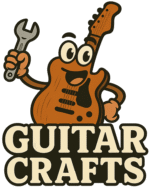When building your dream guitar from a kit, one of the first decisions you’ll face is how to choose between neck-through and bolt-on necks in kits. This critical choice not only impacts the ease of assembly but also affects tone, sustain, playability, and long-term maintenance. Whether you’re chasing a tone-rich sustain monster or just want an easy neck swap down the line, understanding the pros and cons of each neck type is essential before grabbing your screwdriver or wood glue.
Let’s break down the history, construction, sound dynamics, and overall value of neck-through and bolt-on guitar kits — so you can pick the style that best matches your goals.
Introduction to Guitar Neck Types
The neck of an electric guitar is more than just a support for frets and strings — it’s a vital component in shaping the tone, sustain, and structural integrity of your instrument. Guitar kits most commonly offer three types of neck joints:
- Bolt-on: Attached to the body using screws or bolts, typically with a metal plate.
- Neck-through: The neck runs through the entire length of the body with the wings glued on.
- Set neck: Glued into a mortise in the body (think Gibson Les Paul style).
Today, we’re diving deep into the ongoing debate between neck-through vs. bolt-on — two construction styles with fierce advocates on both sides.
** Here’s a little transparency: Our website contains affiliate links. This means if you click and make a purchase, we may receive a small commission. Don’t worry, there’s no extra cost to you. It’s a simple way you can support our mission to bring you quality content. **
As an Amazon Associate, I earn from qualifying purchases.
Neck-Through vs. Bolt-On: The Age-Old Debate
Exploring Neck-Through Construction: Design and Benefits
In a neck-through design, the neck and central body section are one continuous piece of wood, with the body “wings” glued onto either side. This approach offers several advantages:
- Sustain: With uninterrupted wood from headstock to bridge, neck-through guitars are renowned for their extended sustain and resonance.
- Upper Fret Access: No neck heel means smoother transitions to higher frets—great for shredders and lead players.
- Aesthetic Cohesion: Neck-through designs often look cleaner and more custom due to the absence of a visible joint.
However, they’re not without drawbacks. Repairs are complex, and construction is more labor-intensive, increasing the cost.
If you’re looking to maximize resonance in your build, consider reading: Effects Of Different Wood Types On Electric Guitar Tone.
Understanding the Bolt-On Neck Design: Advantages and Disadvantages
The bolt-on neck is exactly what it sounds like — a separate neck bolted (or screwed) into a pre-routed pocket in the guitar body. Made famous by Fender’s early designs, this method is prized for its:
- Ease of Repair: Swap a neck in minutes — ideal for modders and tinkerers.
- Punchy Tone: Bolt-ons are often described as having a snappier, more aggressive attack.
- Affordability: Simpler construction means lower kit prices and less complex manufacturing.
The trade-off? Slightly less sustain (in theory), and a more abrupt heel that can impede access to the highest frets — though modern contoured neck joints mitigate this.
If you’re new to kits, the bolt-on might be the friendlier starting point — check out our guide: Step-by-Step Guide To Building Your First Electric Guitar Kit.
Common Misconceptions: Is Neck-Thru Really Better Than Bolt-On?
Some builders assume neck-through is automatically “better” due to its premium reputation. But that’s not always the case.
- Sound differences are often subtle, especially in live or recorded mixes.
- Sustain isn’t everything — clarity, attack, and ease of maintenance matter too.
- Many pro guitars, including classic Fenders, use bolt-on necks and have defined generations of music.
Don’t buy into the myth that bolt-on equals beginner-grade. Instead, focus on your playing style, tone goals, and upgrade path.
Want to shape your guitar tone even further? Learn how Using Tone Pots And Capacitors To Sculpt Your Sound can help dial in your preferences regardless of neck type.
Sound Dynamics: Do Neck Constructions Matter?
Resonance and Sustain
Neck-throughs theoretically allow sound to travel uninterrupted through the wood, producing more natural sustain. However, pickup selection, wood type, and construction quality also significantly impact tone.
Bolt-on necks may exhibit more attack and brightness, while neck-throughs offer a smoother, more mellow response. These tonal differences are subjective and often influenced by genre. For example:
- Metal players often love neck-throughs for long sustain.
- Blues and funk players may prefer the punchy clarity of bolt-ons.
See our post on Adjusting Pickup Height For Optimal Sound On Your Guitar to see how pickup setup interacts with your neck construction.
Pro Guitarist Perspectives
Ask ten professional players and you’ll get ten different answers. For example:
- John Petrucci of Dream Theater favors neck-throughs for their sustain and smoothness.
- Eric Clapton has stuck with bolt-on Stratocasters for decades, citing their snappy response and familiar feel.
- Guthrie Govan blends elements of both in his custom builds, proving that hybrid approaches also have merit.
Construction and Craftsmanship: Glue vs. Bolts
Set-Neck and Neck-Through: What’s the Difference?
Many people lump set-necks and neck-throughs into the same category due to the glue factor, but they’re different:
- Set-neck: Glued into a pocket (e.g., Gibson style)
- Neck-through: Single-piece core, no pocket
Set-necks offer some of the tonal benefits of neck-throughs but are more cost-efficient and easier to manufacture.
Bolt-On vs. Glued Necks: Which Has Better Tone?
Surprisingly, many players find minimal sonic difference between glued and bolted necks in practical use. Factors like pickup choice, amp settings, and EQ have a much more significant impact.
Still, if you’re after that legendary singing sustain and effortless access to the 24th fret, a neck-through might edge ahead — just expect to pay for the privilege.
Explore more pro kit-building advice here: Tools Needed For Building An Electric Guitar Kit.
Builder Testimonials
- “I prefer bolt-ons because I change necks and fretboards frequently.” – DIY modder and blues guitarist
- “Once I built my neck-through Explorer, nothing else compared for sustain.” – Hard rock player and kit builder
- “Honestly? I can’t hear a huge difference. Play what feels good.” – Studio session player
Your ears and hands are the best judges. Don’t be afraid to experiment.
Pricing and Manufacturing Choices
Why Are Neck-Through Guitars More Expensive?
It comes down to time, materials, and precision. Neck-through builds require:
- Carefully selected multi-piece blanks
- Complex routing and joinery
- Higher levels of craftsmanship
As a result, they’re usually reserved for higher-end kits or custom luthier builds. Bolt-on kits, on the other hand, are quick to machine, ship flat, and assemble easily — perfect for first-timers or modders.
If you’re comparing options, check out Budget Vs Premium Electric Guitar Kits: Which One To Choose? to weigh price against quality.
What Should You Consider When Choosing?
Ask yourself:
- Are you prioritizing tone and sustain, or customization and modding?
- Do you want a project for fun, or a gig-ready instrument?
- Are you confident in your woodworking, or just starting out?
Choose neck-through if:
- You want max sustain and a sleek look
- You’re comfortable with advanced builds
- You don’t mind paying more or sacrificing easy repairs
Choose bolt-on if:
- You like to tinker and swap parts
- You prefer classic tones and snap
- You want an easier, more affordable build
Final Thoughts…
In the great debate of how to choose between neck-through and bolt-on necks in kits, there’s no universal winner — only what’s best for you. Whether you’re chasing endless sustain, a bright vintage snap, or just a fun weekend project, your perfect neck is out there.
So take a deep breath, weigh your priorities, and pick the path that aligns with your goals as a builder and a player.
And if you’re looking for more tips on getting the most out of your build, be sure to read:
Guide To Wiring Your Electric Guitar Kit For Optimal Performance
and
Customizing Your Electric Guitar Kit With Unique Fretboard Inlays.
Need help deciding on a specific kit? Drop a comment or browse the rest of GuitarCrafts.com – your one-stop shop for builder-friendly insights and upgrades.
There are 100’s of ways you can build a business around your passion for guitar building.
Check it out…




This guide does an excellent job of laying out the benefits and trade-offs between neck-through and bolt-on necks in build-your-own guitar kits. I especially appreciate how you clearly highlight the tonal differences—neck-through designs offering extended sustain and seamless access to upper frets, while bolt-ons bring a brighter attack, easier repairs, and modular flexibility. It’s refreshing to see you stress that neither is inherently “better” but rather suited to different priorities, whether that’s sustain, tone character, ease of customization, or budget.
Your inclusion of real-world pros like John Petrucci favoring neck-throughs for sustain and Eric Clapton sticking with bolt-on Strats for that snappy response brings the debate into perspective. The guide empowers readers to match build style to musical goals—not just follow a myth about which construction is superior.
Thank you so much! I’m glad the guide resonated with you. That’s exactly the approach I try to take. Helping builders see that neck-through and bolt-on designs each have their strengths, and the “best” choice really depends on what you value in tone, playability, and maintenance.
I love hearing that the real-world examples helped put things in perspective. Highlighting how pros make their choices is a great way to show that even legendary players prioritize different aspects depending on their style and goals.
It’s rewarding to know the guide helps builders make informed decisions rather than relying on myths, and I hope it encourages them to pick the neck style that best fits their own musical vision!
Thanks again,
~Wayne
This comparison was great. I’ve always admired the look of a neck-through electric guitar kit, because it just feels sleek and custom. I never realized how much the neck style changes the whole building experience of an electric guitar kit. The history part was cool, too — it’s wild how Fender made bolt-ons so popular while others pushed neck-through for sustain.
Glad you enjoyed the comparison! Neck-through kits definitely have that sleek, high-end vibe—you’re right, they look and feel really custom. And you nailed it: the neck style doesn’t just affect tone and sustain, it totally changes how the building process feels too. Fender’s bolt-on approach made guitars way more accessible and easier to service, while neck-through designs became the go-to for players chasing smooth access and long sustain.
It’s pretty cool how both approaches shaped guitar history in their own ways.
Thank you!
~Wayne